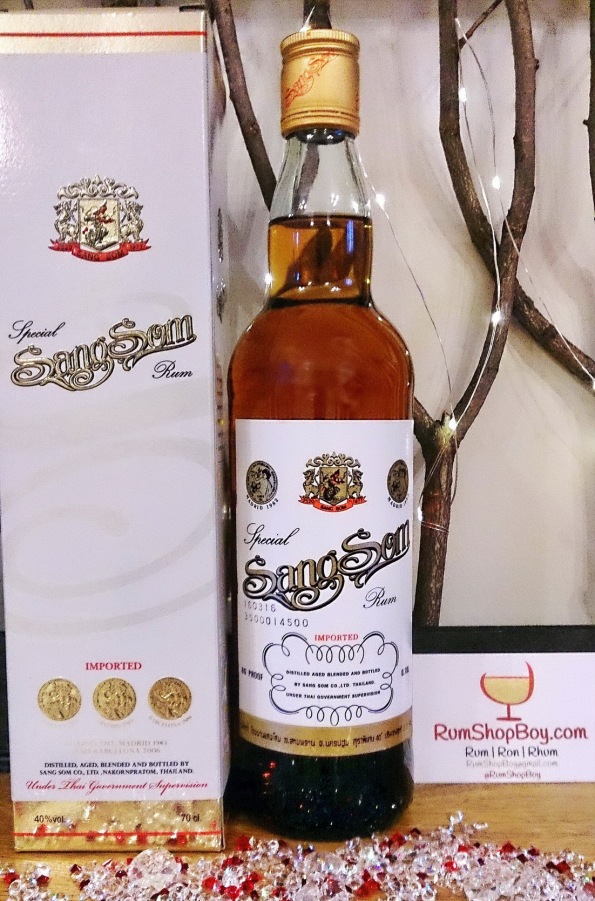Sang Som
Thailand
40%
£17
“Rum” – from a modern multi column still.
ABV Hydrometer Test: 37% ABV @ 20°
* M S
The more one explores the wonderful world of rum, the more one discovers that rum truly is the most universally produced spirit. There really are various cane-derived spirits in every corner of the world.
To the uninformed rum consumer, Thailand is not somewhere that would be readily associated with producing a rum, but they have something of a success story in Sang Som.
Created in 1977 using an allegedly “exclusive oak ageing process and the use of fine Thai herbs. (From Sang Som’s web site)” Quite what is exclusive about this I do not know, methinks this comes across as marketing b*llsh*t though. Putting this aside, Sang Som, translates as meaning “Moonlight” in English, possibly a reference to moonshine, although this is just my speculative opinion. Unfortunately, as is often the case, the official web site for this rum is completely devoid of any useful information about how it is made. A little bit of Internet research leads me to conclude that the rum is column-distilled and then aged for between three and five years in oak barrels, following which some Thai herbs and spices are added. Various sources reference its success in the 1980s, prior to it disappearing from the international scene for several years, re-emerging in the 2000’s. It has recently re-appeared on UK shelves and in the interests of rum-research I bought a bottle to try to see if it is any good or not.
Under Richard Seale’s/Luca Gargano’s proposed rum categorisation, this would most-likely be classed as a “Rum” – from a modern multi column still.
When tested with my hydrometers, the rum came out at 37%, implying that there are around 12g of added sugars.
Bottle/Presentation 1/3

Presented in a basic outer cardboard box, the bottle contained within is a regular design with a cheap metal screw cap. OK, what do I expect for £17? Fair enough!
There is nothing on the label that hints at the methods used in production nor type of still used etc. Just a reference to the “fine ingredients”, secret techniques involved in its production and oak casks used for ageing.
Glass/Aroma 4/10
This is quite an orangey colour. At first it reminded me of the original colour of Lucozade! Closer examination shows it to be slightly more coppery.
Swirling the liquid around the sides of the glass reveal thick, heavy and syrupy legs, which are very quick to drop down the sides of the glass.
The initial aroma is of sticky caramel, some soft spices, light citrus and a delicate background of lightly toasted oak. There is also a hint of cinnamon, coffee and a nutty profile, leading to a burst of coconut.
Taste, Initial-middle 17/40
On entry, this is soft and delicate. The rum is quite light but also slightly sweet, too. There is a certain something that is difficult to put into words. It is herbal but I cannot specifically identify it – must be that diligent usage of “fine Thai herbs.” Beyond the herbs though, the flavour is a little bland and lacking.
Taste, Middle/Throat 28/40
The soft but bland entry becomes a little more interesting in the mid-palate. The flavour develops some smokiness to it alongside vanilla and coconut. As you sip this more, it becomes drier, which surprises me. It also becomes a little more spiced as you continue to sip.
Afterburn 4/7
The rum continues to surprise me and also gets drier throughout the tasting experience. The finish was surprisingly long and had flavours reminiscent of a fine Amontillado Sherry.
TOTAL 54/100

Overall
Given that only 1% of Sang Som’s sales are for export and that it is not something that has been readily available in the UK, when I spotted a bottle in M&S, I couldn’t resist trying it for myself.
Having been recommended Sang Som by someone who visited Thailand, my expectations were not high. Quite often people go on holiday (vacation) and try the local tipple, enjoy it so much that they decide to bring some home with them only to find it is actually pretty poor stuff and in the regular home environment it tastes like paint stripper. One would think that this is something for the tourists to drink in Thailand and that is precisely where it should stay. But I was pleasantly surprised and while it is not something that I would readily reach for in a rum bar, it is certainly worth trying, if only for a bit of variety in your rum and cola, in which Sang Som is surprisingly good. In fact it is actually pretty drinkable even on its own. Given the £17 price tag, it is actually good value, too. Whilst it is not the same quality as something from Appleton or Foursquare, it is not too bad.
Review No. 101

*
P Denotes the rum contains POT still distillate.
C Denotes the rum contains traditional/Coffey COLUMN still distillate.
B Denotes the rum contains a BLEND of POT and COLUMN still distillate.
M Denotes the rum contains MULTI-COLUMN still distillate or is a MODERN rum.
A Denotes the rum is an AGRICOLE i.e. from Cane Juice.
S Denotes the rum is presented in a SWEETENED style.
Marking Guide:
Bottle/Presentation Out of 3
Glass/Aroma Out of 10
Taste, Initial-middle Out of 40
Taste, Middle/Throat Out of 40
Afterburn Out of 7
TOTAL 100



I don’t know if their imported stuff is any different from their local stuff.
But after tasting a bottle that a friend brought it from Thailand, I wouldn’t use it as a paint stripper as I take pity on most of my furniture.
LikeLike
Lol…..I can understand why you would say that.
It is certainly not amazing rum, but it’s nowhere near as bad as many.
LikeLike